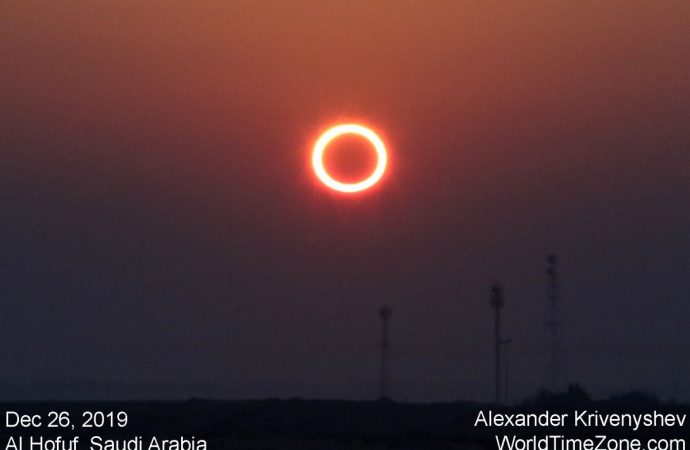It was the last solar eclipse of the decade.
Source: Space.com
The moon crossed the face of the in a dazzling “ring of fire” solar eclipse today (Dec. 26) to the delight of potentially millions of spectators around the world in the Eastern Hemisphere. Even astronauts in space marveled at the view.
The eclipse, known as an annular solar eclipse, began in Saudi Arabia, with the moon passing in front of the sun, but not completely covering the star’s face. Instead, it left a brilliant ring, or annulus, that gave it a “ring of fire” effect. It was the last solar eclipse of 2019, indeed, of the decade.
“It was an amazing experience,” photographer Alexander Krivenyshev of WorldTimeZone.com told Space.com in an email. “This morning’s annular eclipse was during sunrise, with some sand dust by the horizon. [A] beautiful, really beautiful, classic ‘Ring of Fire’ above Saudi Arabia.”
“Here’s what today’s annular solar eclipse (when the Moon is in line in between Earth and the Sun) looked like from @Space_Station,” NASA astronaut Jessica Meir wrote in a Twitter post from the International Space Station. “We saw the shadow of the Moon on the Earth below, just above the horizon (central gray area above horizon).”Image 1 of 4
The Japan Aerospace Exploration Agency’s Himawari 8 weather satellite captured a dazzling video of the moon’s shadow moving across Earth. The U.S. National Oceanic and Atmospheric Administration shared the video on Twitter.
Solar eclipses occur when the new moon passes between the sun and the Earth, appearing to cover part (a partial eclipse) or all (a total eclipse) as viewed from the Earth’s surface. Because the moon’s orbit has a tilt, this cosmic alignment doesn’t occur every month. Sometimes, the moon is a bit too far from Earth in its orbit to completely cover the sun, resulting in an annular eclipse like the one today.
The solar eclipse began at 9:23 p.m. Dec. 25 EST (0223 Dec. 26 GMT) as a partial solar eclipse, then reached its first “ring of fire” at 10:34 p.m. EST (0334 GMT) in Saudi Arabia. The 88-mile (142 km) visibility path of “ring of fire” then moved across Bahrain, Qatar, the United Arab Emirates, Oman, India, Sri Lanka, Sumatra, Singapore, Borneo, the Philippines and the U.S. territory of Guam.
Thursday’s solar eclipse was the last of three in 2019. A partial solar eclipse occurred on Jan. 6 and a total solar eclipse occurred on July 2.
It was also the last solar eclipse of the decade, which saw 24 solar eclipses since 2010.
The next solar eclipse will occur on June 21, 2020, and will also be a “ring of fire” solar eclipse. That eclipse will be visible from parts of Africa, southeastern Europe and Asia, with the “ring of fire” effect visible primarily from central Africa, south Asia, China and the Pacific Ocean, according to eclipse scientist Fred Espenak.
But you don’t have to wait until June for the next eclipse.
On Jan. 10, there will be a minor penumbral lunar eclipse, in which the moon passes through the outer region of Earth’s shadow. It will be visible to observers across Europe, Africa, Asia and Australia, according to Espenak.
There will be four lunar eclipses in 2020, all of them penumbral.
The new year will also include two solar eclipses. In addition to the annular solar eclipse of June 21, there will be a total solar eclipse on Dec. 14, 2020.
Source: Space.com

































Leave a Comment
You must be logged in to post a comment.